Freakonomics: A Dime Museum Man Speaks Candidly
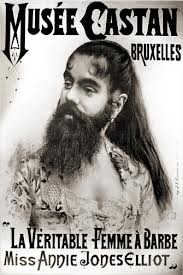
Freakonomics: A Dime Museum Man Speaks Candidly
“I fear ” — said the manager of the dime-museum, as the living skeleton sat on him and intermittently hammered him — “I fear my curiosity has got the best of me.”
-Indianapolis Journal 1898-
There is always something exciting and immediate about a first-person interview with a specialist in his field. In these pages and over at my other blog, we’ve previously seen chats with a maker of mermaids a tattoo artist, a carnival gaff maker, and a seller of shrouds. I’ve also looked at a few “freaks,” which do not always make for comfortable or politically correct reading. This article is a gossipy, yet dollars-and-cents look at the economics of the dime museum freak show. Who knew that there were fashions in freaks?
MONEY VALUE OF A FREAK
“Yes,” said the dime museum man “I’ve had a liberal education in freaks. I’ve been right here in Fourteenth street for fifteen years and, take it all together, I’ve associated with a greater galaxy of weird wonders than any other man alive.”
“Which was the weirdest of them all?”
“I rather think it was the Tocci twins. Did you ever meet them? No? Well, they got the biggest salary we ever paid to any freak. They got $700 a week.
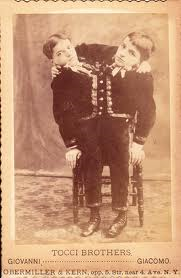
“That would be $350 apiece.” “Apiece? But there’s only one of ‘em. That is—you see—well, it’s kind of complicated. You see, they had one pair of legs and one body up to the waist and from there up they were twins. Of course, if you’re going to divide the money between them, why, I have known other freaks that have earned more. But I guess it wouldn’t have done to give the money to ‘em anyway. They’d have had a quarrel over it, sure.”
“Didn’t they live together in brotherly love?”
“Well, not always. You see, their tastes differed. There was one of them that loved beer and the other wouldn’t drink anything but mineral water. One of them, you see, was rather peaked and effeminate while the other was hearty and strong. He was the one that liked the beer, you know. Of course, when he drank his beer it used to go to the other fellow’s head and then there’d be trouble. I was for passing a prohibitory law, but their manager believed in local option, so of course I couldn’t help it.
“But the little one used to get even. He had a mania for gambling and would play cards every time he got a chance. No, they didn’t play against each other in private life. The big one wouldn’t. And he used to be madder than anything when he had to sit there and watch the little one.
“Of course if he could drink enough beer to get the little one sleepy, he could break up the game, but one can’t be thirsty to order, you know. It was a very complicated case.
“They were Italians, the Tocci twins. Italy’s about the best country for producing freaks. India produces a good many, too. I guess India’s crop is the largest, but India has an enormous population. American freaks are the cleverest. Most of the imported ones are just born that way and they let it go at that. But the American ones have more enterprise. Lots of them aren’t really born freaks. They achieve that state or they have it thrust upon them.
“There was Jonathan R. Bass, for instance. He was known as the ossified man and I consider him the most interesting freak I have ever seen. He wasn’t born that way. He said he was all right until he was sixteen years old when he fell into the river where he was rafting hogs.
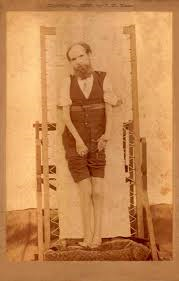
Jonathan R Bass, The Ossified Man
“He took cold, had rheumatism, and suffered excruciating pain for a number of years. Finally the pain left him, but he became perfectly stiff. He couldn’t move a single joint with the exception of an occasional twitching of one toe. He was blind, but he could hear and talk, though he had to talk through his teeth owing to the stiffness of his jaws.”
“Didn’t he want to die?” “Die? No! He was happy. He loved to have people read the papers to him and he would talk politics by the hour. He was an ardent Democrat and would argue questions of the day with as much interest as anybody. He got from $300 to $350 a week; but he had to have two men to take care of him and of course his traveling expenses were heavy.
“His brother finally got control of him and was exhibiting him when somehow they dropped him. He never got over that. He was under contract to play here but he sent me word asking me to release him; said he hadn’t felt well since they let him fall and he believed he was going to die. He wanted to go back to his old home and die there. Of course I released him. They took him out there to Western New York and he died two days after he reached there.
“I see that one of the Wild Men of Borneo died the other day. Those men were good attractions, though they didn’t earn big money. They got from $75 to $150. They were genuine freaks of nature, but they never saw Borneo. They were born up in Massachusetts, I believe, and the man who traveled with them at first was their father.
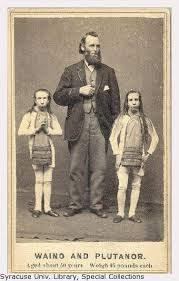
The Wild Men of Borneo
“Later their own brother, who didn’t happen to be a freak, went with them. You know they never spoke a word when on exhibition. I guess the only language they knew anything about was Massachusetts English, so they observed a discreet silence.”
“How about giants? Are they worth much as freaks?”
“No, not so very much nowadays. Ella Ewing got more than any other giant I know of. She got as high as $200 a week. The best male giant I ever saw was the American Kansas giant, who measured 7 feet 4 ½ inches in his stocking feet. But he only got from $75 to $100 a week. People are suspicious of giants, for some reason or other. Of course, the height can be increased a few inches by artificial means, but that’s all.
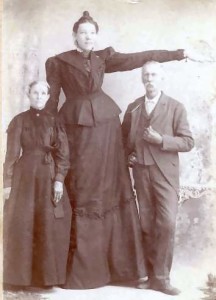
Giantess Ella Ewing
Dwarfs are rather out of fashion, too. They don’t get very much unless they can do something in what we call the working line. Major Mite [Clarence Chesterfield Howerton], who died not long ago, was one of the best of the little people. He was bright and intelligent, could give a good song and dance and entertain a whole audience. He earned from $150 to $200 a week, but there are not many dwarfs who are worth that much. He was an interesting little chap. Would smoke a cigar like a man and could drink as much as I can. He drank too much, unfortunately, and that really caused his death.
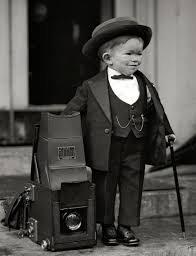
Major Mite
“He was an exception, though. Most of the freaks are well to do. The dwarfs, especially, are very thrifty and you’ll find that almost all of them have their money invested in real estate. It seems to appeal to them somehow.
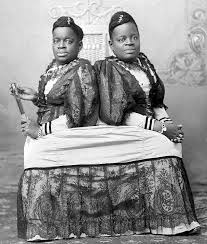
Millie-Christine, Conjoined Twins
“One of the biggest salaries we have ever paid was the Millie-Christine. Millie-Christine was twins—that’s another of these complicated cases—united by a ligament as the Siamese twins were. They were colored and they were about the swellest freaks we ever ran across. They had a white man for a manager and a white woman to take care of them. They wouldn’t play on Sunday and they wanted—and sometimes got $500 a week.”
“Now, there’s an interesting freak,” pointed to the picture of a heavily bearded woman. “That’s Ada Jones and she’s as nice a woman as ever lived. She used to get from $75 to $200 a week. She’s over in Europe now doing a vaudeville act.
“Most of the freaks are in Europe, by the way. They get bigger salaries and longer engagements over there. Here we rarely play a freak longer than four weeks, but over there they stay months in the same place.
“The interest in freaks isn’t what it used to be in this country. The present generation has seen most of the specimens and we must wait a few years for a revival of interest.
“Of course a novelty in freaks is always a good attraction. There was the man with the broken neck, for instance. He was a good attraction when he first came out. He had a sort of framework which supported his head in place, but when that was opened in front his head simply fell down onto his breast. It would almost make you faint to see him do it.
“Yes, he was genuine. They had him up at Bellevue and all the hospitals and examined him. That fellow dies hard, I tell you. He was in the Galveston cyclone and got through with his life all right. He lost everything else, I guess, for he wrote and asked me for money, which I sent him.
“I say he lost everything else. He didn’t. He lost his child, but not his wife. Married? Well, rather. He married one woman, separated from her and married another. You can’t break that man’s spirit by breaking his neck.
“Speaking of necks reminds me of another good freak I know. That’s the Human Giraffe, or Original Rubber Neck Joe. He could stretch his neck out to a phenomenal length, but that wasn’t so remarkable as the elasticity of his skin. You could take the skin of his cheek between your thumb and finger and pull it out several inches just as if it were of rubber. He got about $50 a week, which wasn’t bad for simply rubbering. By the way, it’s interesting to know that the original rubber necker came from Jersey.
“Then there was Wilson, the man who could expand his chest twenty-four inches. He was the original expansionist in this country. Poor fellow! He’s in Boston now, and I understand he’s pretty dissipated. I suppose there are so many anti-expansionists in Boston that they’ve driven him to drink. He ought to have known better than to try to introduce his specialty up there.”
“How about Albinos?”
“Oh, they’re not worth much. They’re too common. They don’t draw unless they can do something in the working line. For instance, that man out there with the trained canaries is married to an Albino, who sings and dances. Here’s another Albino,” showing a picture, “who is married to the King of the Broom Makers. They work together. She sings and dances, and he gives exhibitions of broom making.
“Here’s a souvenir I have of one of our freaks. He was called the Human Ostrich, and he fed, apparently, on nails, tacks, knife blades and other rather indigestible articles. See that broken blade in my knife? He just bit it off one day. That was his playful way. Then he said he swallowed it.
“No, I don’t believe he did, but he used to put those little delicacies on his tongue, apparently swallow them, drink a glass of water and nobody ever could find them. He would let you examine his mouth, but nobody ever found anything there except his tongue and teeth.
“I always found the Human Pincushion interesting too. You could stick pins into him by the paperful. He must have been invaluable to his wife. I do think he ought to have gone on the police force though, for a hatpin hadn’t any terror for him.
“We used to run a hatpin through his cheek and he’d only smile the brighter. We drove nails into him, too, but he didn’t mind it. Bleed? No, there was no blood—nor sawdust either. He was a Quaker product. Came from Philadelphia. The Human Ostrich was a New Yorker. That isn’t so strange as some other things, is it?
“There was one class of freaks we used to have that we haven’t played with for some time. They were the fasters. There was Stratton, the only man who actually went over thirty-six hours without eating a thing. He fasted forty-two days, then the police interfered and took him to a hospital. They didn’t believe there that he hadn’t eaten anything, and they gave him whisky and champagne. They had to put him in the alcoholic ward and he promptly died. They performed an autopsy on him and found out that he actually hadn’t eaten anything.
“He didn’t get a regular salary. He got a percentage of the receipts, the percentage being increased every week he continued to fast. He began with perhaps $100 and went up from that. When he died the money was paid over to his mother.”
“How about armless freaks?”
“They are too common to be worth anything unless they can do things. If an armless man can draw or paint sew, write and do other things of that sort with his feet, he can earn perhaps $50 per week. Of course Juggernaut, the armless and legless boy from India was worth more than that. He had him with Lolo and the orange-headed girl and we paid the three about $300 a week.
“It pays better to be a long than a short when it comes to freaks. For instance, it’s better to have three legs than none at all. We had a three-legged Italian boy who was one of our best freaks. But, then, he was bright and attractive.
“There is still another class of freaks and that is the animal freaks. There are six-legged horses, three-legged hens, two headed calfs, albino possums and so on. These freaks aren’t worth much; not more than few dollars, especially as we don’t care to keep them in the museum long.
“But up in Essex county, where I have a farm, there isn’t a freak animal which the inhabitants do not think I ought to buy and at a big price. The best animal attraction we ever had was the horse with a great mane and tail. But that was a peculiarity of that particular race of horses. It ran in the family.”
“Do most of the good freaks find their way into the museum?”
“No, indeed. Many of them are never seen. The friends will not allow their exhibition, sometimes even when it would mean escape from real poverty. In other cases the law will not permit the exhibition of a freak because of its being under 16. This law operates very cruelly sometimes.”
The Appeal [St Paul, MN] 16 March 1901: p. 1
Stratton—mentioned towards the end—was H. George Stratton, a “Hunger Artist” who was trying to beat Giovanni Succi’s record of fasting for 45 days. The account of Stratton’s death above sounded a little improbable, but was corroborated by this, from The Lancet:
Death of a Fasting Man
That the “fasting experiments” which have of late become so numerous are full of risk to the chief person concerned with not be disputed. An account is given in the Boston Medical and Surgical Journal, Nov. 26th, 1891, of a fatal attempt to fast for forty-five days. A man named George Stratton attempted to perform this feat. After going for thirty-seven days and one hour on water alone, his physician ordered him two teaspoonsful of champagne a day. At the end of forty-one days and eighteen hours and a half, however, symptoms of heart failure became so marked that it was at once decided to stop the fast. The champagne which was given him while in an extremely debilitated condition appeared to bring on alcoholism, and the next day he was transferred to a hospital. There he was treated with stimulants and peptonized food, but was unable to rally, and died two days after admission The necropsy showed that death had resulted from cerebral congestion caused by alcohol, with fatty degeneration of the heart as a contributory cause. Stratton was a man thirty years old and of immense physique. At the commencement of his fast he weighed 270 ¾ lb., and at the end 211 lb. 8 ½ oz., a loss of nearly 60 lb. The Lancet, Volume 1, 9 January 1892. Another article alarmingly notes that “He was the last of several contestants who undertook to break [Giovanni] Succi’s record of 45 days.”
An article on the closing of Huber’s Museum at 106 E Fourteenth Street in New York, reported that the dime museum had been bought out by the German restrauranteur, Albert Lüchow. [New York Times 16 July 1910]. Is the dime museum described above Huber’s or were there other dime museums on Fourteenth Street? A “Professor” Hutchinson, a “lecturer” or guide to the wonders of the Dime Museum, aged 83, is mentioned in the New York Times article. One wonders if he is the candid interviewee? Thoughts on dime museums, “freaks,” or hunger artists? Step right up to Chriswoodyard8 AT gmail.com
Chris Woodyard is the author of The Victorian Book of the Dead, The Ghost Wore Black, The Headless Horror, The Face in the Window, and the 7-volume Haunted Ohio series. She is also the chronicler of the adventures of that amiable murderess Mrs Daffodil in A Spot of Bother: Four Macabre Tales. The books are available in paperback and for Kindle. Indexes and fact sheets for all of these books may be found by searching hauntedohiobooks.com. Join her on FB at Haunted Ohio by Chris Woodyard or The Victorian Book of the Dead. And visit her newest blog, The Victorian Book of the Dead.
